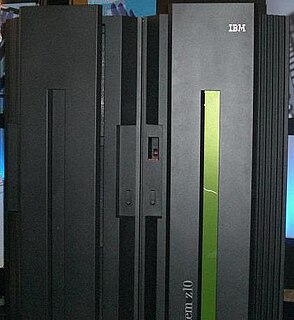Parallel Sysplex

IBM introduced [1] the Parallel Sysplex with the addition of the 9674 [2] Coupling Facility (CF), new S/390 models, [3] [4] [5] upgrades to existing models, coupling links for high speed communication and MVS/ESA SP V5.1 [6] operating system support, in April 1994. [7]
The Coupling Facility (CF) may reside on a dedicated stand-alone server configured with processors that can run Coupling Facility control code (CFCC), as integral processors on the mainframes themselves configured as ICFs (Internal Coupling Facilities), or less common, as normal LPARs. The CF contains Lock, List, and Cache structures to help with serialization, message passing, and buffer consistency between multiple LPARs. [8]
The primary goal of a Parallel Sysplex is to provide data sharing capabilities, allowing multiple databases for direct reads and writes to shared data. This can provide benefits of
- Help remove single points of failure within the server, LPAR, or subsystems
- Application Availability
- Single System Image
- Dynamic Session Balancing
- Dynamic Transaction Routing
- Scalable capacity
Databases running on the System z server that can take advantage of this include:
- IBM Db2
- IBM Information Management System (IMS).
- VSAM (VSARM/RLS)
- IDMS
- Adabas
- DataCom
- Oracle
Other components can use the Coupling Facility to help with system management, performance, or reduced hardware requirements. Called “Resource Sharing”, uses include:
- Catalog – shared catalogs to improve performance by reducing I/O to a catalog data set on disk
- CICS – Using the CF to provide sharing and recovery capabilities for named counters, data tables, or transient data
- DFSMShsm – Workload balancing for data migration workload
- GRS Star – Reduced CPU and response time performance for data set allocation.
Tape Switching uses the GRS structure to provide sharing of tape units between z/OS images.
- Dynamic CHPID Management (DCM), and I/O priority management
- JES2 Checkpoint – Provides improved access to a multisystem checkpoint
- Operlog / Logrec – Merged multisystem logs for system management
- RACF – shared data set to simplify security management across the Parallel Sysplex
- WebSphere MQ – Shared message queues for availability and flexibility
- WLM - provides support for Intelligent Resource Director (IRD) to extends the z/OS Workload Manager to help manage CPU and I/O resources across multiple LPARs within the Parallel Sysplex. Functions include LPAR CPU management, IRD.
Multi-system enclave management for improved performance
- XCF Star – Reduced hardware requirements and simplified management of XCF communication paths
Major components of a Parallel Sysplex include:
- Coupling Facility (CF or ICF) hardware, allowing multiple processors to share, cache, update, and balance data access;
- Sysplex Timers (more recently, Server Time Protocol) to synchronize the clocks of all member systems;
- High speed, high quality, redundant cabling;
- Software (operating system services and, usually, middleware such as IBM Db2).
The Coupling Facility may be either a dedicated external system (a small mainframe, such as a System z9 BC, specially configured with only coupling facility processors) or integral processors on the mainframes themselves configured as ICFs (Internal Coupling Facilities). [9] It is recommended that at least one external CF be used in a parallel sysplex. [10] It is recommended that a Parallel Sysplex has at least two CFs and/or ICFs for redundancy, especially in a production data sharing environment. Server Time Protocol (STP) replaced the Sysplex Timers beginning in 2005 for System z mainframe models z990 and newer. [11] A Sysplex Timer is a physically separate piece of hardware from the mainframe, [12] whereas STP is an integral facility within the mainframe's microcode. [13] With STP and ICFs it is possible to construct a complete Parallel Sysplex installation with two connected mainframes. Moreover, a single mainframe can contain the internal equivalent of a complete physical Parallel Sysplex, useful for application testing and development purposes. [14]
The IBM Systems Journal dedicated a full issue to all the technology components. [15]






